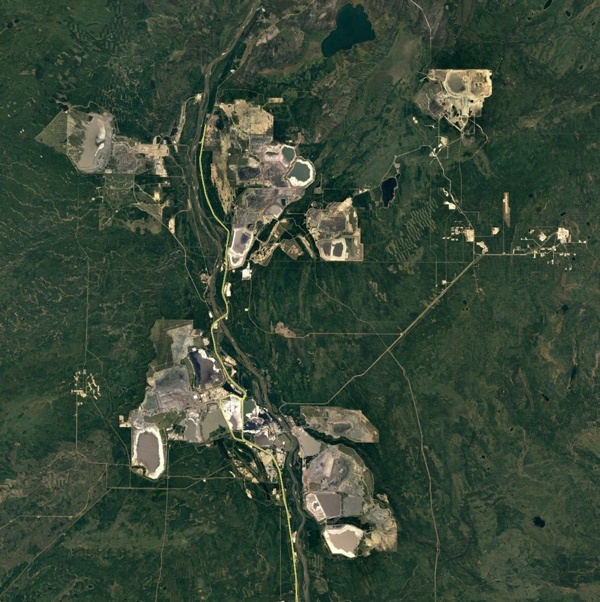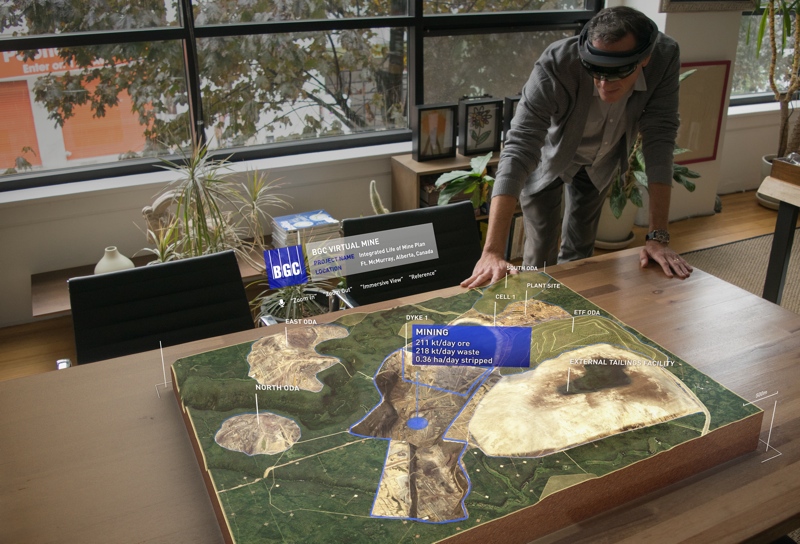BGC Engineering works across the world on some of the most difficult geotechnical mining, pipeline, geohazard, and hydroelectric problems. However, one of the earth-sciences engineering firm’s biggest challenges is helping clients, stakeholders, and owners understand the work they do. How could they demonstrate complex engineering concepts to non-technical project stakeholders? How could they help community members understand the long-term effects of project design choices?
BGC’s search for a solution led to LOOOK, a Seattle-based mixed-reality design and development studio. If any group of people can be called veterans of mixed reality, LOOOK’s team can: The company includes members from Microsoft’s original HoloLens development team who have worked on mixed-reality projects with companies as diverse as NASA and Trimble, and on applications that Microsoft shipped with the launch of HoloLens. Since LOOOK’s founding at the beginning of 2016, they’ve developed a wide variety of mixed-reality solutions, ranging from 3D-data visualization for a global auditing firm to a training application for operators of heavy industrial equipment.
Together, BGC and LOOOK are developing 3D-visualization tools for HoloLens that offer a better way to communicate, visualize, and make decisions about complex engineering projects. In the process they’re offering a glimpse into a legitimate 3D-data revolution, one that offers huge benefits for non-technical customers and tech-savvy employees alike.
A HoloLens Solution for Customers

Suncor Pond 1 / Wapisiw Lookout tailings reclamation, before and after.
First up, BGC and LOOOK are piloting a HoloLens app for mine-closure planning, visualization, and communication. The app shows stakeholders a holographic representation of a mine that they can examine in overview, or explore at 1:1 scale.
Virginia Cullen, BGC’s Vice President and Senior Hydrogeological Engineer, says that this app helps BGC to communicate the whole timeline of a project to non-technical stakeholders, “from the undisturbed mine site, to an operating mine, to what we call a closed mine at the end.”
BGC is planning to use this app to help build engagement with project planners and local communities, says Senior Geotechnical Engineer Matthew Lato. By exploring the landscape, he says, community members will be able to understand what a planned mine will look like after it has been closed and reclaimed by nature. They can also offer their input: “Are the wetlands the right size? Are the hills the right size? We’re taking something that’s very complex engineering and turning it into something that is very real for people who are going to use the land.”
Helping non-technical stakeholders to participate in the planning and design process is invaluable, says Cullen. Otherwise, “you get to the end of the project and not everyone is on the same page—and it’s too late.” Mistakes like this can be very costly to correct.
Solutions like the HoloLens mine-closure app that BGC developed with LOOOK offer “a way of communicating a future landscape in a way that strengthens the social contract before the project even begins.”

Syncrude Sandhill Fen tailings watershed reclamation project
A HoloLens Solution for Engineers
During my conversation with BGC and Loook, the two companies were adamant that mixed-reality technology also has immense value within the design process. And it’s not just for remote collaboration—it can also help engineers to make better, more confident decisions.
Lato says that the partnership has developed other HoloLens applications, including one that can combine a number of different data sets into a single interactive view. For a mining project, this might include data on dams, subsurface flow of water, vegetation cover, and engineering data. “Typically,” he says, “those are separated out to different components of a project deliverable. Using the HoloLens, we were able to combine all the different types of information in one very coherent environment that we can visualize fairly seamlessly.” With all that data in one place, decision-making becomes much easier.

The oil sands region of northeastern Alberta, Canada. Source: Google Earth
John Howard, Creative Director and co-founder of LOOOK, told an anecdote about another benefit. When the project began, he said, Cullen explained that she was working on a mine reclamation project for which she had done the engineering drawings herself. She had carefully spec’ed the size of the hills for the reclamation project, but once she stood in the constructed landscape, she found them to be much, much larger than she had expected from examining 2D drawings.
“Being able to look at it at 1:1 scale,” Howard says, “gives you all sorts of insights and understanding that you wouldn’t get in the abstract.”
Reaching Mixed-Reality’s Full Potential
As great as HoloLens technology will be, and as much enthusiasm as BGC engineers have shown about using it, there are still certain challenges ahead. Not the least of them being the familiar resistance from the old guard.
Howard argues that the way to convince people is to demonstrate the positive impact it can have on existing processes, existing workflows, and existing toolchains. “That’s where you’re going to have the greatest success,” he says, “because people are going to see that value and see that the benefits outweigh any costs.”
It’s also best to get started soon, if BGC and LOOOK are any indication. The two companies clearly believe that mixed-reality is the biggest technological disruption since the smartphone. According to Howard, “this is going to become the dominant way people interact with information, because it is less abstract, and more natural and intuitive.”
LOOOK’s CEO, Sébastien Motte, takes it one step further. “The reason is that 3D is the natural language of the brain. So your ability to get insights, understand, and retain the information is exponentially higher.”
In other words, mixed-reality is nothing less than a revolutionary step toward exploiting the full potential of 3D data.






